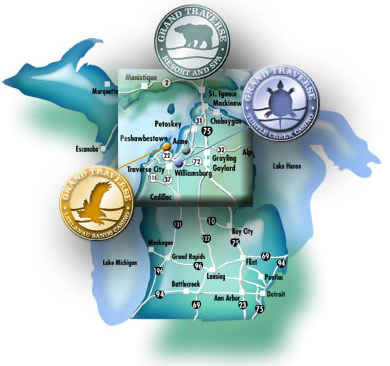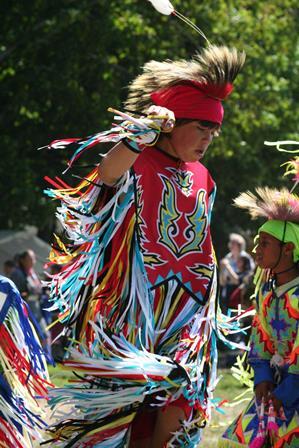Grand Traverse Band of Ottawa and Chippewa Indians
TIME PERIOD
Jennifer Horne
Introduction

Alcoholism has been a huge concern among the Native American communities. It is one of the leading causes of deaths among Natives, specifically in northern plains or remote areas. The Grand Traverse Band of Ottawa and Chippewa Indians have taken alcoholism, and other substance abuse addictions, seriously and have several programs to educate and treat these addictions within their community. As a sovereign nation, Grand Traverse Band, strives to honor their ancestor, traditions, and culture, and to empower present and future members. With these goals, to implement culture and education, the tribe has created cultural centric treatments and prevention of alcoholism available to all tribal members.
As a federally recognized tribe and with the Economic Development Program the tribe owns both the Turtle Creek Casino and Hotel and the Leelanau Sands Casino and Lodge. They also own the Grand Traverse Resort and Spa and The Eyaawing Museum and Cultural Center. With these economic revenues the tribe is able to provide resources to its tribal members such as: dental, medical, behavioral, cultural, housing, education, natural resources, and tribal court. These resources have been very successful with increasing the community’s health and wellbeing. In the behavioral unit at GTB they have extensive resources and excellent staff to treat, prevent and educate members about alcoholism.
History

Grand Traverse Band of Ottawa and Chippewa Indians is a federally recognized tribe in the northwest portion of Michigan’s lower peninsula. Grand Traverse Band people are the Three Fires Confederacy, the Odawa (Ottawa), Ojibwa (Chippewa) and Bodowadomi (Pottawatomi). According to their oral history traces them back t the Eastern coast of Turtle Island where their ancestor told them that they should travel west until they found food growing on the water. When they found rice growing on water they knew they were home, here they began trading and established routes across the country. After two wars, between the French and England and then between the English and Americans, the US Government brought a treaty to the people in 1836, and in 1837 the State of Michigan was established from lands ceded in the treaty. The people reserved lands for their own use and use of ceded lands and they reserved their hunting, fishing and gathering rights in this treaty. In 1855 the US government brought another treaty for the people to sign ceding the remaining third of Michigan to the US Government. During this treaty it included most of Leelanau County and Antrim County, this land was illegally taken and had to be re-purchased by the people. Between 1855 and 1980 the Bureau of Indian Affairs determined that by signing the treaty the tribe was no longer federally recognized. Under the Indian Reorganization Act in 1934 the GTB tribe applied for federal recognition and were denied. They again applied for federal recognition in 1943 which they were denied then in 1978 they applied and were finally federally recognized in 1980. In 1983 the tribe developed Tribal programs to serve the memberships and established an Economic Development Corporation which allowed them to establish businesses for the tribe. With these businesses the tribe has been able to provide many forms of assistance to their members of the Grand Traverse Band of Ottawa and Chippewa Indians (GTB website).
Effects of Alcohol on Native Americans
Alcohol was introduced to Natives Americans when western settlers arrived and began trading in the 16th and 17th centuries. During this time many natives drank “firewater” to cope with cultural changes. Today, just like then, many Natives use alcohol as a coping mechanism. Some factors for Native drinking are socioeconomic issues like; poverty, unemployment, and job insecurity and social issues such as; challenges to traditional ways of life and values, culture change, changes in family dynamics, and relations with nature (Lamarine, 1988). Acculturation is another factor because the stress to fit into modern dominant white society lowers Natives self-esteem (Lamarine, 1988). Traditional ways of life of Native Americans are challenged and criticized by modern society because they are different. These same social and economic issues are still evident in today’s society among Native American communities, and have significant effects on Native youth. Fewer Native students will graduate high school and even fewer will continue onto college, and nearly twice as many will live in poverty (Lamarine, 1988). Within the Native community alcohol is introduced at a young age. Many families drink socially and binge drink during social events with children around. Drinking within the family seems to influence the level of adolescent alcohol use and in a study about one-third of adolescents had their first drink with a close family member (Lamarine, 1988). In another study by Oetting and Goldstein, of 3,000 native adolescents, found that 72 percent of natives ages 12 to 17 had tried alcohol compared to 53 percent of the general population (Lamarine, 1988).
The effects of alcohol within the Native population have serious problems including accidents, health, mental and emotional issues. Chronic liver disease, cirrhosis, suicide, and homicide are four of the top ten causes of death among Native Americans which are all alcohol related (Cameron, 1999). Higher rates of depression, suicide, traumatic injuries, and premature deaths plague Native youth due to alcohol use and deaths are nearly twice that of other ethnic groups (Cameron, 1999).
Grand Traverse Band Treatments
The Grand Traverse Band of Ottawa and Chippewa Indians have significant resources available to their members dealing with substance and alcohol abuse. The Grand Traverse Band behavioral health services goals are to promote healthy alcohol and drug free lifestyles that are spiritually balanced and culturally specific with Native American values (GTB website). The GTB also has a traditional healer on site promoting culturally based curriculum, a sweat lodge, talking circle, individual spiritual support, spiritual and cultural teachings, storytelling, tribal song and dance group, and tribal arts and crafts.

Grand Traverse Bands Behavioral Health Services provides care to individuals, family, and couples dealing with stressful or emotional situations and substance use and abuse disorders. GTB’s behavioral health services is a state licensed outpatient Substance Abuse Program which provides screenings, assessment referral and follow-up, (S.A.R.F.) and community change, alternatives, information, and training (C.A.I.T.). All of GTB’s behavioral health service clinical staff are licensed by the state of Michigan for mental health counseling. A contracted psychiatrist is also available one day per week for medication management, therapy, and psychological assessments for adult patients. The staff also assist with inpatient residential treatment referrals for substance abuse disorders and help with after care plans and support for ongoing sobriety when they return home, into the community.
In addition to the behavioral health services the tribal court has taken interest in alcohol and other substance abuse prevention specifically targeting addicts. The tribal court developed and runs a program called the Healing to Wellness Drug Court Program to help members with alcohol and/or drug related offenses break the cycle of addiction.
Movement Towards Cultural Centric Treatments

Traditional, or westernized, treatments and Cultural centric treatments cater to differently to people of different races, or cultures. It has been estimated by Indian Health Services that 70 percent of all treatment services are alcohol related because of unsuccessful Nativistic treatments (Lamarine, 1999). These Western treatment models focus on psychiatric approaches and Alcohol Anonymous (Lamarine, 1999). Alcohol Anonymous is centered around whites and are not culturally diverse. With cultural relevant features added into Alcohol Anonymous has shown that Native Americans respond better and are more successful in sobriety. Native American variations an Alcoholics Anonymous have had a major response to substance abuse treatment because they have incorporated elements of Native traditions such as the medicine wheel, purification sweat and sacred pipe as healing devices (French, 2004). The Native variation of AA has the same basic AA values but from a cultural centric perspective which Native Americans can understand and accept (French, 2004). Some of the differences in the Native version is a more collectivism idea rather than an individualistic idea. For example, American Indian AA focuses on cooperation, sharing, happiness, tradition, smallness, and unity with nature while the Traditional AA focuses on competition, ownership, success, innovation, bigness, separateness with nature (French, 2004).
The most successful treatments for Native alcoholics have been planned, implemented, and organized at a community level by other Native Americans. A lack of Native American cultural insight and understanding is a major impediment to success (Lamerine, 1999). More successful treatments for Native Americans are ones that include the use of traditional native healing methods and practitioners, and the inclusion of Native American staff (Lamarine, 1999). Native American traditional healing encompasses a range of holistic treatments for acute ailments to chronic conditions (Koithan and Farrell, 2010). Stories and legends, herbs, manipulative therapies, and prayer are used in various combinations to prevents and treat illness (Koithan and Farrell, 2010). Symbolic healing is another traditional treatment used by Native Americans that involves ceremonies for the overall wellbeing, cueing bio-psycho-social-spiritual healing responses (Koithan and Farrell, 2010). These ceremonies can involve the patient, the family, and the community in the healing process. Culture is important to a person’s identity and increase their self-esteem giving them a sense of being and purpose which is why traditional indigenous treatments have a higher success rate in Native American communities.
Further Reading
For further information and articles on the effects and concerns about alcoholism, the importance of culture, or more general information about the Grand Traverse Band of Ottawa and Chippewa Indians then visit: The devastating rate of suicide among American Indian teens, 1 in 10 Native American deaths alcohol related, Native Americans: The Tragedy of Alcoholism, and The Grand Traverse Band Website. There is also an ethnographic book by Erica Prussing on understanding Native alcoholism and sobriety, cultural treatment,
References
Written
Cameron, Lane, A,. (1999). “Understanding Alcohol Abuse in American Indian/Alaskan Native Youth.” Pediatric Nursing, 25 (1999): 297-300.
Farrell, Cynthia., Koithan, Mary. “Indigenous Native American Healing Traditions.” J Nurse Practitioner, 6(6) (2010): 477-478. doi: 10.1016/j.nurpra.2010.03.016.
French, Laurence, Armand,. “Alcohol and Other Drug Addictions among Native Americans.” Alcoholism Treatment Quarterly, 22:1 (2004): 81-91. http://dx.doi.org/ 10.1300/1020v22n01_06
Grand Traverse Band of Ottawa and Chippewa Indians website: http://www.gtbindians.org/
Lamarine, Roland, J., “Alcohol Abuse among Native Americans.” Journal of Community Health, 13 (1988): 143-155.Images
Image 1. Grand Traverse Band Economic Development Map. gtbindians. Retrieved from gtbindians.org
Image 2. Grand Traverse Band Seal. traverseticker. Retrieved from traverseticker.com
Image 3. Medicine Lodge Sign. gtbindians. Retrieved from gtbindians.org
Image 4. Grand Traverse Band member at GTB Jiigtamok (powwow). michiganradio. Retrieved from stateofopportunity.michiganradio.org